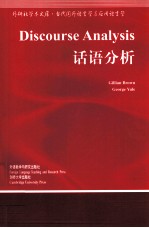

话语分析PDF电子书下载
- 电子书积分:11 积分如何计算积分?
- 作 者:(英)布朗(BrownG.)等著
- 出 版 社:北京:外语教学与研究出版社;剑桥大学出版社
- 出版年份:2012
- ISBN:7560085296
- 页数:293 页
1 Introduction: linguistic forms and functions1.1 The functions of language 1
1.1. 1 The transactional view 1
1.1.2 The interactional view 2
1.2 Spoken and written language 4
1.2.1 Manner of production 4
1.2.2 The representation of discourse: texts 5
1.2.3 Written texts 6
1.2.4 Spoken texts 9
1.2.5 The relationship between speech and writing 12
1.2.6 Differences in form between written and spoken language 14
1.3 Sentence and utterance 19
1.3.1 On ‘data’ 20
1.3.2 Rules versus regularities 22
1.3.3 Product versus process 23
1 .3.4 On ‘context’ 25
2 The role of context in interpretation 27
2.1 Pragmatics and discourse context 27
2. 1.1 Reference 28
2.1.2 Presupposition 28
2.1. 3 Implicatures 31
2.1.4 Inference 33
2.2 The context of situation 35
2.2.1 Features of context 36
2.2.2 Co-text 46
2.3 The expanding context 50
2.4 The principles of ‘local interpretation’ and of ‘analogy’ 58
3 Topic and the representation of discourse content 68
3.1 Discourse fragments and the notion ‘topic’ 68
3.2 Sentential topic 70
3.3 Discourse topic 71
3.3.1 Topic framework 73
3.3.2 Presupposition pools 79
3.3.3 Sentential topic and the presupposition pool 81
3.4 Relevance and speaking topically 83
3.5 Speaker's topic 87
3.6 Topic boundary markers 94
3.6.1 Paragraphs 95
3.6.2 Paratones 100
3.7 Discourse topic and the representation of discourse content 106
3.8 Problems with the proposition-based representation of discourse content 114
3.9 Memory for text-content: story-grammars 116
3.10 Representing text-content as a network 121
4 ‘Staging’ and the representation of discourse struc-ture 125
4.1 The linearisation problem 125
4.2 Theme 126
4.3 Thematisation and ‘staging’ 133
4.3.1 ‘Staging’ 134
4.3.2 ‘Theme’ as main character/topic entity 134
4.3.3 Titles and thematisation 139
4.3.4 Thematic structure 140
4.3.5 Natural order and point of view 144
4.3.6 Theme, thematisation and ‘staging’ 148
5 Information structure 153
5.1 The structure of information 153
5.1.1 Information structure and the notion‘given/new’ in intonation 153
5.1.2 Halliday's account of information structure: information units 154
5.1.3 Halliday's account of information structure: tone groups and tonics 155
5.1.4 Identifying the tone group 157
5.1.5 The tone group and the clause 159
5.1.6 Pause-defined units 160
5.1.7 The function of pitch prominence 164
5.2 Information structure and syntactic form 169
5.2.1 Given/new and syntactic form 169
5.2.2 Information structure and sentence structure 176
5.3 The psychological status of ‘givenness’ 179
5.3. 1 What does ‘given’ mean? 179
5.3.2 A taxonomy of information status 182
5.3.3 The information status taxonomy applied to data 184
5.4 Conclusion 188
6 The nature of reference in text and in discourse 190
6.1 What is ‘text’? 190
6.1.1 ‘Cohesion’ 191
6.1.2 Endophora 199
6.1.3 Substitution 201
6.2 Discourse reference 204
6.2.1 Reference and discourse representations 206
6.2.2 Referring expressions 208
6.3 Pronouns in discourse 214
6.3.1 Pronouns and antecedent nominals 215
6.3.2 Pronouns and antecedent predicates 216
6.3.3 Pronouns and ‘new'predicates 218
6.3.4 Interpreting pronominal reference in discourse 221
7 Coherence in the interpretation of discourse 223
7.1 Coherence in discourse 223
7.2 Computing communicative function 226
7.3 Speech acts 231
7.4 Using knowledge of the world 233
7.5 Top-down and bottom-up processing 234
7.6 Representing background knowledge 236
7.6.1 Frames 238
7.6.2 Scripts 241
7.6.3 Scenarios 245
7.6.4 Schemata 247
7.6.5 Mental models 250
7.7 Determining the inferences to be made 256
7.8 Inferences as missing links 257
7.9 Inferences as non-automatic connections 260
7.10 Inferences as filling in gaps or discontinuities in interpreta-tion 265
7.11 Conclusion 270
References 272
Subject index 284
Author index 286
文库索引 289
- 《水面舰艇编队作战运筹分析》谭安胜著 2009
- 《分析化学》陈怀侠主编 2019
- 《影响葡萄和葡萄酒中酚类特征的因素分析》朱磊 2019
- 《仪器分析技术 第2版》曹国庆 2018
- 《全国普通高等中医药院校药学类专业十三五规划教材 第二轮规划教材 分析化学实验 第2版》池玉梅 2018
- 《Power BI数据清洗与可视化交互式分析》陈剑 2020
- 《行测资料分析》李永新主编 2019
- 《药物分析》贡济宇主编 2017
- 《土壤环境监测前沿分析测试方法研究》中国环境监测总站编著 2018
- 《你的话语是我沉默中开出的花朵》(法)安东尼·帕耶著 2019
- 《断陷湖盆比较沉积学与油气储层》赵永胜等著 1996
- 《古代巴比伦》(英)莱昂纳德·W.金著 2019
- 《BBC人体如何工作》(英)爱丽丝.罗伯茨 2019
- 《一个数学家的辩白》(英)哈代(G.H.Hardy)著;李文林,戴宗铎,高嵘译 2019
- 《莎士比亚全集 2》(英)莎士比亚著,朱生豪等译 2002
- 《莎士比亚戏剧精选集》(英)威廉·莎士比亚(William Shakespeare)著 2020
- 《莎士比亚 叙事诗·抒情诗·戏剧》(英)威廉·莎士比亚著 2019
- 《亚历山大继业者战争 上 将领与战役》(英)鲍勃·本尼特,(英)麦克·罗伯茨著;张晓媛译 2019
- 《孩子们的音乐之旅 1 宝宝睡觉 幼儿版》包菊英主编 2016
- 《液固旋流分离新技术》中国化工学会组织编写;汪华林等著 2019
